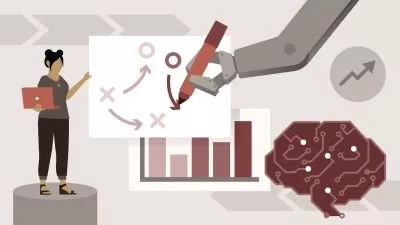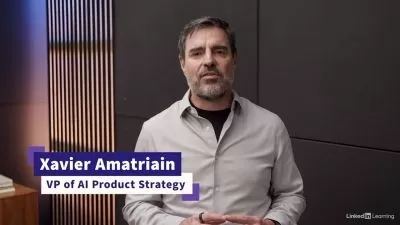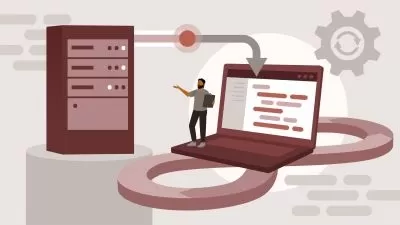UML Basics to AI-Powered UML!
Santanu Das
6:59:50
Description
Unlock Architect-Level Design Skills with UML and AI: Turn Complex Systems into Child's Play!
What You'll Learn?
- Unlock Your Future as a Software Architect: Master UML and Design Software with Ease
- From Developer to Architect: Simplify Complex Systems with UML Mastery
- Elevate Your Career: Become a Software Architect with UML Expertise
- Transform Your Software Career: Learn UML and Step Up to Architecture
- Revolutionize Your Software Design Skills: Master UML and Soar to New Career Heights
- Speak the Language of Leaders: Learn UML and Become a Software Architect
- Don't Just Code—Architect! Master UML and Lead Your Projects to Success
Who is this for?
What You Need to Know?
More details
DescriptionUnlock Your Future as a Software Architect: Master UML and Design Software with Ease
Don't Just Code—Command! I'll Transform You from Developer to Architect with UML Expertise. Make Software Design Your Second Nature."
AI in UML: Discover the power of generative AI in automating and enhancing UML diagram creation.
Are you a software developer looking to escalate your career and transition into software architecture? Look no further. This course is designed to bridge that gap, transforming you from a skilled developer into a visionary software architect.
Coding is Just the Start: Soar to Architect Status with UML Mastery! Design, Communicate, and Lead Projects with Unmatched Clarity
Why This Course Is Essential:
As software development evolves, there's an increasing need for professionals who can see the big picture, create robust system designs, and lead teams effectively. Understanding Unified Modeling Language (UML) is crucial for anyone aspiring to become a software architect. UML serves as the common language that fosters clear communication, collaboration, and a shared understanding among team members and stakeholders.
Skyrocket Your Career from Coder to Architect: Master UML and Design Systems that Wow Stakeholders. Be the Architect Everyone Needs!
What You'll Learn:
Master UML: Grasp the essential UML diagrams and how they contribute to a project’s success.
Transitioning Skills: Practical steps to shift from a software developer to a software architect role.
Team Leadership: How to communicate effectively with stakeholders and lead a development team.
Design Principles: Master the art of designing robust and scalable software architectures.
Course Highlights:
Hands-on UML projects
Real-world case studies
A special 15-minute video on leveraging generative AI for UML diagramming
Interactive quizzes and assignments
Expert-led video lectures
Peer discussions and network opportunities
Who This Course Is For:
This course is ideal for software developers, junior architects, project managers, technical leads, software analysts, and anyone interested in progressing into software architecture roles.
Elevate Your Code to Architecture: Master UML and Become the Software Architect You're Meant to Be! Cut Through Complexity and Design Like a Pro.
Prerequisites:
Basic to intermediate programming skills
Familiarity with software development lifecycles
A willing mind and eagerness to learn
Course Outcomes:
Proficient understanding of UML
Understanding of how AI can streamline and innovate UML diagram generation
Ability to design complex software systems
Enhanced leadership and communication skills
Certificate of Completion
Enroll today to transition from coding tasks to leading architectural visions and designing software with ease!
Unlock Architect-Level Design Skills: I Fast-Track Developers into Master Architects with UML—Turn Complex Systems into Child's Play!
Quantifiable End Outcomes:
UML Proficiency: Ability to create and interpret at least 10 different types of UML diagrams accurately.
Design Skills: Demonstrated ability to design a medium-complexity software system, evidenced by a capstone project or a set of smaller projects throughout the course.
Communication Metrics: Gain the skill to effectively communicate complex system designs to both technical and non-technical stakeholders, evidenced by peer and instructor assessments.
Leadership Ability: Lead at least one team project or simulation during the course, applying best practices in workflow management and team communication.
Exam Scores: Achieve an average score of 85% or above on all course assessments, quizzes, and final exams focused on UML and software architecture principles.
Who this course is for:
- Software Developers: Those who have experience in coding but are looking to broaden their skill set and understand the architectural aspects of software projects.
- Junior Architects: Individuals who have recently moved into an architectural role and want to formalize and deepen their knowledge.
- Project Managers: Those who are responsible for software projects and want to understand the architectural aspects to manage their teams better.
- Technical Leads: Team leaders who often find themselves making architectural decisions but lack formal training in software architecture.
- Software Analysts: People who are involved in requirements gathering and want to understand how their work translates into software architecture.
- Quality Assurance Engineers: QA professionals who want to understand the architectural context to create better test cases and strategies.
- Data Scientists & Engineers: Those who work closely with software projects and want to understand how architecture can affect scalability, reliability, and performance.
- Technology Enthusiasts: Anyone interested in software design and architecture as a field, even if they do not code regularly.
- Computer Science Students: Students who have a good grasp of programming basics and wish to explore a more specialized career path within software development.
- Career Switchers: Professionals from other industries with some coding experience looking to transition into software architecture roles.
Unlock Your Future as a Software Architect: Master UML and Design Software with Ease
Don't Just Code—Command! I'll Transform You from Developer to Architect with UML Expertise. Make Software Design Your Second Nature."
AI in UML: Discover the power of generative AI in automating and enhancing UML diagram creation.
Are you a software developer looking to escalate your career and transition into software architecture? Look no further. This course is designed to bridge that gap, transforming you from a skilled developer into a visionary software architect.
Coding is Just the Start: Soar to Architect Status with UML Mastery! Design, Communicate, and Lead Projects with Unmatched Clarity
Why This Course Is Essential:
As software development evolves, there's an increasing need for professionals who can see the big picture, create robust system designs, and lead teams effectively. Understanding Unified Modeling Language (UML) is crucial for anyone aspiring to become a software architect. UML serves as the common language that fosters clear communication, collaboration, and a shared understanding among team members and stakeholders.
Skyrocket Your Career from Coder to Architect: Master UML and Design Systems that Wow Stakeholders. Be the Architect Everyone Needs!
What You'll Learn:
Master UML: Grasp the essential UML diagrams and how they contribute to a project’s success.
Transitioning Skills: Practical steps to shift from a software developer to a software architect role.
Team Leadership: How to communicate effectively with stakeholders and lead a development team.
Design Principles: Master the art of designing robust and scalable software architectures.
Course Highlights:
Hands-on UML projects
Real-world case studies
A special 15-minute video on leveraging generative AI for UML diagramming
Interactive quizzes and assignments
Expert-led video lectures
Peer discussions and network opportunities
Who This Course Is For:
This course is ideal for software developers, junior architects, project managers, technical leads, software analysts, and anyone interested in progressing into software architecture roles.
Elevate Your Code to Architecture: Master UML and Become the Software Architect You're Meant to Be! Cut Through Complexity and Design Like a Pro.
Prerequisites:
Basic to intermediate programming skills
Familiarity with software development lifecycles
A willing mind and eagerness to learn
Course Outcomes:
Proficient understanding of UML
Understanding of how AI can streamline and innovate UML diagram generation
Ability to design complex software systems
Enhanced leadership and communication skills
Certificate of Completion
Enroll today to transition from coding tasks to leading architectural visions and designing software with ease!
Unlock Architect-Level Design Skills: I Fast-Track Developers into Master Architects with UML—Turn Complex Systems into Child's Play!
Quantifiable End Outcomes:
UML Proficiency: Ability to create and interpret at least 10 different types of UML diagrams accurately.
Design Skills: Demonstrated ability to design a medium-complexity software system, evidenced by a capstone project or a set of smaller projects throughout the course.
Communication Metrics: Gain the skill to effectively communicate complex system designs to both technical and non-technical stakeholders, evidenced by peer and instructor assessments.
Leadership Ability: Lead at least one team project or simulation during the course, applying best practices in workflow management and team communication.
Exam Scores: Achieve an average score of 85% or above on all course assessments, quizzes, and final exams focused on UML and software architecture principles.
Who this course is for:
- Software Developers: Those who have experience in coding but are looking to broaden their skill set and understand the architectural aspects of software projects.
- Junior Architects: Individuals who have recently moved into an architectural role and want to formalize and deepen their knowledge.
- Project Managers: Those who are responsible for software projects and want to understand the architectural aspects to manage their teams better.
- Technical Leads: Team leaders who often find themselves making architectural decisions but lack formal training in software architecture.
- Software Analysts: People who are involved in requirements gathering and want to understand how their work translates into software architecture.
- Quality Assurance Engineers: QA professionals who want to understand the architectural context to create better test cases and strategies.
- Data Scientists & Engineers: Those who work closely with software projects and want to understand how architecture can affect scalability, reliability, and performance.
- Technology Enthusiasts: Anyone interested in software design and architecture as a field, even if they do not code regularly.
- Computer Science Students: Students who have a good grasp of programming basics and wish to explore a more specialized career path within software development.
- Career Switchers: Professionals from other industries with some coding experience looking to transition into software architecture roles.
User Reviews
Rating
Santanu Das
Instructor's Courses
Udemy
View courses Udemy- language english
- Training sessions 38
- duration 6:59:50
- Release Date 2023/12/06















